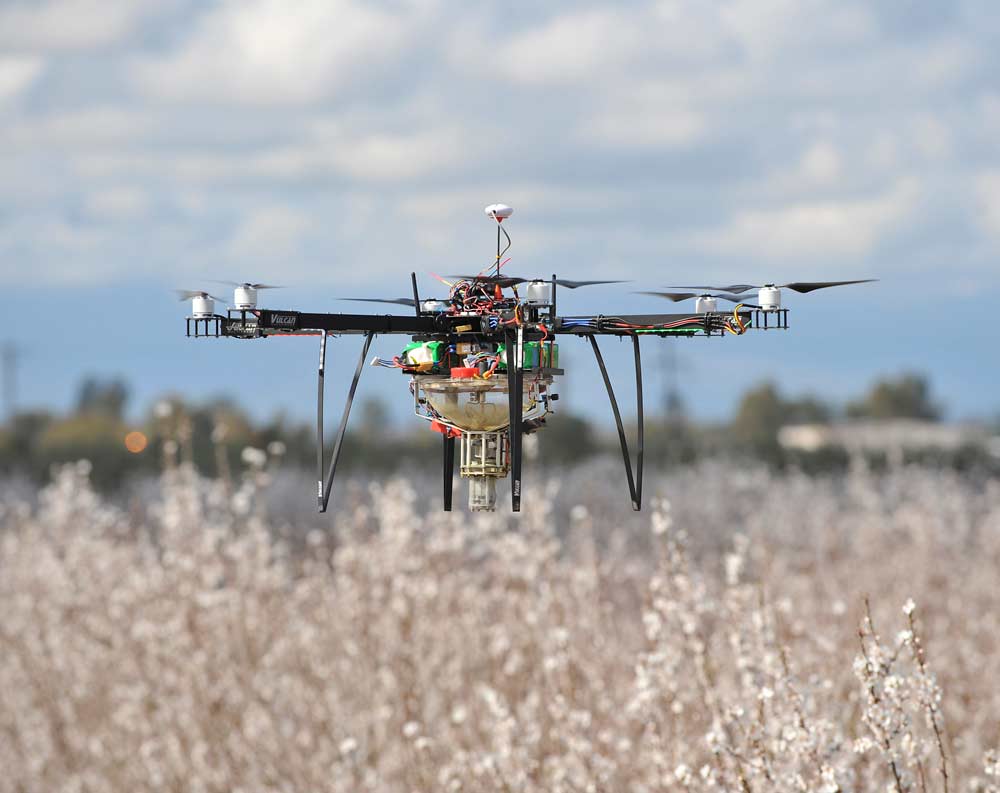
A first-generation prototype pollinator unit attached to the bottom of an industrial drone. (Courtesy Dropcopter)
The bees had a buddy this year in New York’s Beak and Skiff Apple Orchard — a drone that helped to pollinate some 300 acres of apple trees.
Peter Fleckenstein, the fifth-generation general manager of the company’s fresh fruit operation, expressed interest in the idea when he heard a small start-up company operating in nearby Syracuse had been experimenting with drone pollen delivery in almonds.
“In New York state, it seems like we get a week where it goes to 75 or 80 degrees in May. Beautiful weather, beautiful bloom, then we just shift to 40 and rainy,” he said. “There has been more than one year where we have wondered if we are going to get any pollination.”
Since the drone company, Dropcopter, had started to show success in almonds, Fleckenstein’s question was simple: How do we scale this up?
There’s a window, he said, when the weather might ease up during the day or at night, when bees don’t fly, where pollination by drone could be helpful.
“That’s what caught my attention. If I can just mitigate the risk, at this one point in the season, I’m that much closer to the end goal.”
Dropcopter, based in California and central New York, has been testing drones to pollinate almond orchards, as a supplement to bees, since 2015. The company has expanded those efforts to cherries and, this year, helped Beak and Skiff in Lafayette, New York, to pollinate 300 acres.
The company’s patent-pending device distributes a measured amount of pollen directly over the tree canopy.
The company contends that drones could serve as a useful supplement for when bees are unavailable or weather prevents them from flying. A drone can cover 40 acres per hour and fly at night — an advantage over bees that don’t fly after dark, though flowers remain open then for pollination.
“The drone flies an autonomous prewritten mission optimizing its speed to deliver the most effective application,” Dropcopter co-founder and CTO Adam Fine told Digital Trends.
Depending on environmental conditions, such as weather, trials in almonds and cherries this year showed an increase of 25 to 60 percent in pollination set, Fine said.

Prototype pollinator unit that would be attached to the bottom of an industrial drone. (Courtesy Dropcopter)
However, a grower doesn’t necessarily want every bloom pollinated in an apple orchard, for fear that could mean high thinning costs later.
Beak and Skiff, founded in 1911, sees some 5,000 cars a day at its large retail and U-pick operation. Its fresh cider plant supplies most of the major regional grocery chains, and the company has created a hard cider line called 1911 and opened its own distillery.
For the fresh market, the orchards grow primarily Gala, Honeycrisp and Fuji, but the operation still grows the Empire, McIntosh and Cortland varieties upon which the farm was built. New plantings are generally in high-density 3 foot-by-12 foot spacing.
Full bloom typically hits May 25; it can be 90 degrees some years, 40 degrees others, Fleckenstein told Good Fruit Grower. And this year wasn’t a perfect test for the drone, because pollination was near perfect.
“We had the most beautiful pollination weather for eight days straight: 75 degrees, no wind, sunshine,” he said. “We had the largest fruit set we’ve had in years across the farm, so from the grower perspective, the drive by, I couldn’t tell the difference.”
But the Dropcopter crew was attentive to the bloom schedule and ready, and the drone flew right alongside the bees, he said. He also said he can’t wait to test it again next year.
“Would I not rent bees next year? No. But will we do more of a test block and net it, so no bees get in to test it out? Absolutely,” he said. “We can help these guys out. It’s worth seeing if this is a viable option. Any technology you can get in the orchard is worth trying.” •
—by Shannon Dininny






Read your article, was a good read. I wanted to share with you our pollination drone we’ve been developing since 2016. Our drone the Poli-X (current prototype Poli-X2) has been running tests in actual gardens since 2017. The Poli-X drone though not designed to replace bees, does pollinate more like bees.
If you would like to find out more about our project, please feel free to contact me.
Thanks!